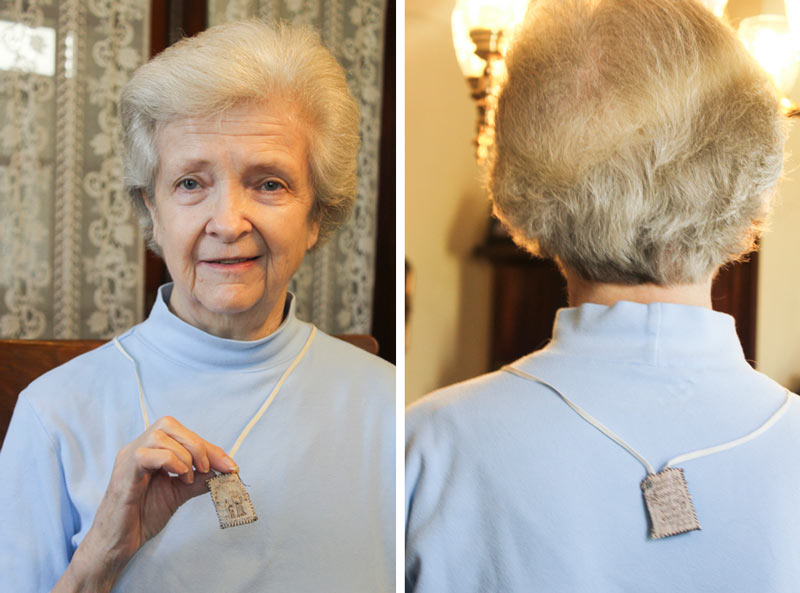
Two squares of brown wool connected by a simple white cord are a perpetual symbol of Karen Blackwell’s belief.
Blackwell, who attends St. Elizabeth Ann Seton Church in Simpsonville, is a member of the Lay Carmelites, a third order, or lay religious organization, associated with the Carmelites.
Blackwell, and other members of the Lay Carmelites, wear an item known as the Brown Scapular of Our Lady of Mount Carmel, an item that for more than 800 years has existed as a visual emblem of the Carmelite devotion to Jesus Christ and the Blessed Mother.

There are several other types of scapulars, but the brown scapular is by far the best known in Catholic tradition.
A scapular is not a piece of jewelry, but rather a constant reminder of the wearer’s devotion and faith. The term scapular comes from the Latin word scapula, which means shoulder. There are two types: the monastic and the devotional.
Monastic scapulars, which are long garments that cover the front and back of the wearer, are part of the traditional habit of most religious orders of monks and nuns. The tradition of wearing a monastic scapular is thought to have started with the Benedictines, and the original garment is said to be adapted from the typical aprons worn by working people.
These large symbols evolved into the smaller, devotional scapulars worn by lay people who wanted a visible sign of their faith.
People like Blackwell who join third orders commit themselves to follow a rule of order and participate in disciplines of prayer and service while living in the secular world.
According to tradition, the brown scapular became a part of Carmelite tradition because of an appearance by the Blessed Mother to St. Simon Stock in Cambridge, England, in 1251. Stock was praying for members of his order who were experiencing oppression, and Mary is said to have been holding the scapular in her hand. She told the saint to wear the scapular as a symbol of the Carmelite order and to consider it a sign of her grace and protection. According to the Catholic Encyclopedia, she described the scapular as “a special sign of grace; whoever dies in this garment, will not suffer everlasting fire. It is the sign of salvation, a safeguard in dangers, a pledge of peace and of the covenant.”

As part of that tradition, Lay Carmelites wear the scapular today as a reminder of their devotion to Christ and to Mary.
All members of the Lay Carmelites wear a larger version, called the ceremonial scapular, during meetings and special Masses. The larger scapular is a darker brown and bears the initials BVM for “Blessed Virgin Mary” and IHS, a symbol of the holy name of Jesus.
The smaller brown scapular bears an image of Our Lady of Mount Carmel on one square and the words “Whoever wears this scapular shall not suffer from eternal fire” on the other.
In the past, there have been various traditions and superstitions passed down about the brown scapular, some erroneously stating that Mary would help get those who wore it out of purgatory on the first Saturday after their death. Blackwell said this was a misinterpretation of Mary’s promise to St. Simon.
Current teaching on the scapular says that those who wear the brown scapular and practice devotion will receive special graces from the Blessed Mother, including her intercession for their salvation after death.
Devotional scapulars are typically worn with one square in the front, the bands going over the shoulders, and the other square hung over the wearer’s back.

Some people, for whatever reasons, find a traditional woolen scapular uncomfortable and unwieldy, and in that case, special medal forms of the scapular are permitted.
Anyone can wear a brown scapular as a sign of devotion, but to receive full benefit of Mary’s promises to St. Simon, Carmelites believe that a wearer needs to be enrolled in the Confraternity of the Scapular. This is a simple ritual of specific prayers that can be done by any priest.
Merrilee Hill, leader of the Lay Carmelite group at St. Joseph Church in Columbia, said she has been wearing the brown scapular for more than 20 years.
“It certainly reminds me of my commitment to the Carmelites, and it’s just a constant reminder of faith and prayer,” Hill said. “It’s part of me, intimately connected with everything I do.”
While the brown scapular is by far the best known, there are other popular scapulars. They include the green scapular, known as the “Badge of the Immaculate Heart of Mary”; the blue scapular, associated with the Immaculate Conception; and the Blessed Trinity Scapular, which is white with a red and blue cross, and said to have been given in a vision to St. John of Matha in 1190. He went on to found the order of the Trinitarians.
Photos by Christina Lee Knauss/Miscellany: Top photo: Merilee Hill, a member of the Lay Carmelites at St. Joseph Church in Columbia, shows the Brown Scapular, or Scapular of Our Lady of Mount Carmel, that she wears constantly. One square of wool is worn on the front and the other hangs down the back.



